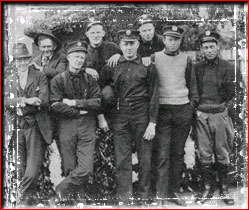
|
On July 1, 1922, the last of the volunteers were replaced by full-time paid firemen. At this time, the department consisted of the Fire Chief, Assistant Chief, 11 drivers and 15 firemen. For equipment there were 3 first line engines, 1 reserve engine, and a ladder truck located in three fire stations. |
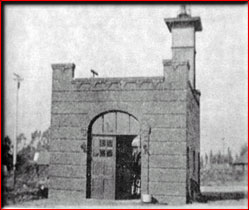
|
First Station in 1907. In May of 1907, the voters of the City of Glendale approved a $5,000 bond issue, with this money our first fire station was built and the Glendale Fire Department was born. In addition to the new fire station, two fire hydrants were installed, 800' of hose was purchased and to provide mobility, a horse and wagon were acquired. The City's first station once stood on Howard Street next to the present day Public Service building. Behind the Fire Station's horse stall an iron cage was built which served as the city's jail. |
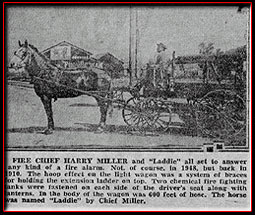
|
Fire Chief Harry Miller in 1910. Harry M. Miller doubled in brass to serve as Glendale's first City Marshall as well as Fire Chief from 1907-1914. As Fire Chief he organized the first volunteer fire company consisting of a horse drawn wagon and 25 men. With these meager beginnings, this group of spirited citizens received their first big test on June 9, 1910; Glendale's first major fire. The fire started in the yards of the Valley Lumber Company, located at the corner of Broadway and Maryland. Although the fire did not spread to adjoining property, the loss of this company proved that fire protection had lagged behind the growth of the city. |
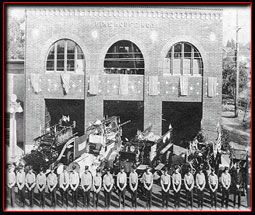
|
Fire Station 1, 311 E. Broadway, completed and occupied in Feb. 1914. After the fire, the board of trustees ordered another bond election so that the fire defenses of the city could be improved. By 1913 the money from the bonds was used to construct a new headquarters fire station on east Broadway (where the main post office now stands). Along with the new station, the first motorized fire engine was purchased. This engine was manufactured by Knox Truck Company and was one of the first engines built by this company. |
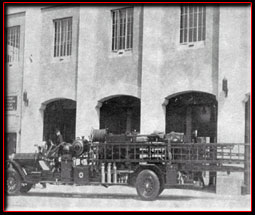
|
With the coming of motorized equipment, it was necessary to hire a permanent full-time driver. To fill this position, a garage mechanic named A.H. Lankford was appointed as Glendale's first full-time paid fireman at a salary of $80.00 a month. In July 1919, Lankford was appointed Glendale's first Fire Chief at a salary of $110.00 a month. The work week at that time was a continuous 24 hour duty with 3 hours off each day for meals. After working seven days, a day off was granted. This schedule continued in effect until September 1919, when the two platoon system was adopted Station #1, 1929 with quad truck. The truck, a 1926 American LaFrance had no aerial ladder, but carried ground ladders, water, a 400 gpm pump, and various other equipment. When it was retired in the 1940's, it went to Fawnskin near Big Bear where it was modified to fight fire in the lumber camp. It went through several owners until the Glendale Muster Club found it in a vacant lot in 1979. It has been restored and now goes to parades and has won many awards. |
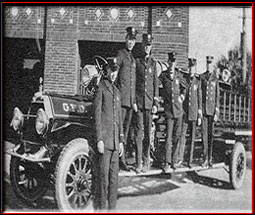
|
1924 - Glendale Fire Department's Knox City Service Truck in front of the first Fire Department Headquarters. Harry Elliot, George Blix, Al Psenner, Dean Williams, Lawrence Olsen and Frank Kiefer. (Collection of Captain T.V. Phillip) |
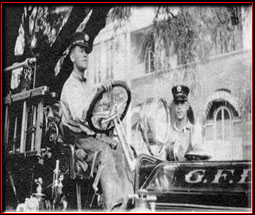
|
1924 - Glendale fire Department engine in front of Wilson School. Driver Al Psenner; standing Al Collection of Captain T.V. Phillip) |
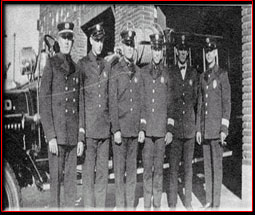
|
1924 -Captain Frank Kiefer, Harry Elliot, Al Psenner, George Blix, Dean Williams, Al Moniot in front of Fire Department Headquarters. (Collection of Captain T.V. Phillip) |

|
1924 - In front of the first Glendale Fire Department Headquarters, 311 E. Broadway. Seated are Al Moniot and Dean Williams, in the rear are Harry Elliot and Al Psenner.(Collection of Captain T.V. Phillip) |
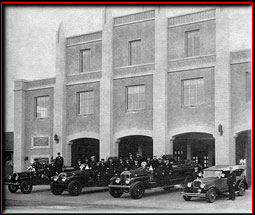
|
New Fire Station 1, built in 1926 at 210 South Orange Street. Built for a growing community. |
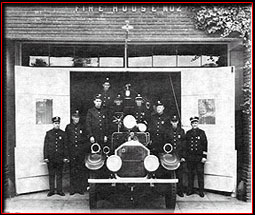
|
Fire Station 2's new home, built in 1926. |
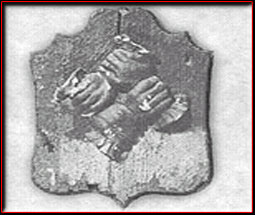
|
In the early days of the fire service it was all volunteer. In order to pay for equipment needed to fight fires, the insurance companies used fire marks. Each volunteer company had its own fire mark. If a business caught on fire, the volunteers would respond to extinguish the fire. The insurance company would then pay the volunteers for saving the building. If a business didn't have a fire mark displayed, the volunteers wouldn't put out the fire. |
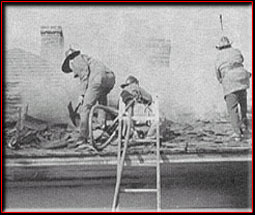
|
Ventilation Operations - There has always been a spirit of competition in the fire service, so much so, that in the early days if there was a large fire, more than one volunteer company arrived at the same time. Many times a fight would break out between the companies to see who would fight the fire and be paid by the insurance company. During the ensuing altercation the building would burn down. Zones were eventually set up for each company and if more than one company was needed the insurance company would pay all companies involved. 1946 - House Fire, 138 S. Adams |
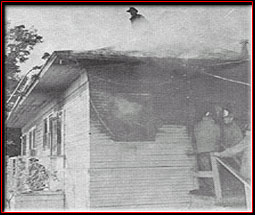
|
1946 - House Fire, 138 S. Adams - Fire fighters responded to many house fires and aside from helmets and turnout coats made of heavy canvas, they had very little protection. Although breathing apparatus was available (one on each fire engine), they were kept in compartments, checked once a day and forgotten. This went on until the mid 1970's when it was found that there were many heart attacks, lung disease, and many other negative reactions from smoke inhalation. Now, every firefighter has their own breathing apparatus on their rig, which is checked everyday. Specially trained personnel repair them when damaged. |

|
In 1923 Chief Lankford and Captain Thomas Philip purchased a Curtis Bi Plane and used it for the first time to observe fire from the air. Curtis Jenny JN4D, used for observing fires from the air. It was probably the first airplane to be used for the fire service. Beginning in the late 1950's the fire service has continually improved on it's ability to attack wildland fires. The use of helicopters has much improved the ability of fire departments to stop and control brush fires in rough terrain that many fixed wing aircraft would have difficulty attacking. |
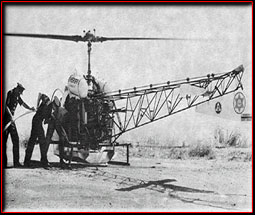
|
Early version of water dropping copter, 150 gallons capacity. Some of the first helicopters carried large bucket type containers slung under the airship attached with cables. They had a water carrying capability of 150 gallons. |
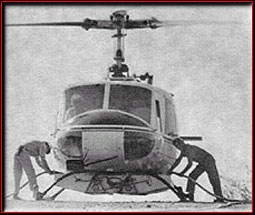
|
LA County copter #7, being loaded with 360 gallons of water. Our more modern helicopters can carry 360 gallons of water and with our crews manning a landing site, are capable of reloading and dumping water on the fire in a matter of minutes. |
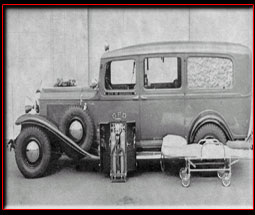
|
1936 - Cadillac ambulance which responded from Fire Station 2. Paramedic services have been provided to the city by a private ambulance company from 1976 to 1998. Prior to 1976 the service was provided by the Fire Department. Starting in 1999 the paramedic services will once again be provided by the Glendale Fire Department. |
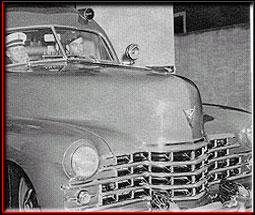
|
1947 Cadillac Ambulance - In 1932, the City Council funded the beginnings of the Fire Department ambulance. During the first year the ambulance responded to 375 calls. Two firefighters from each shift were assigned to the ambulance on a rotating basis to serve as either driver or officer, thus allowing each firefighter to work in this important capacity at some point in his career. The total number of calls logged in the final year of service was over 1500. |
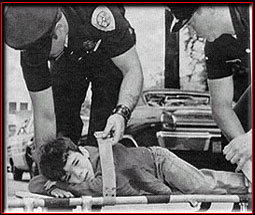
|
Circa 1970, Dave Brandt and Don Busik pick up a child that was involved in a traffic accident. Due to the large brush area of the city (approximately 1/3 of the total city) and the continuing fire problems, city officials formed the "Fire in the Hills Committee." Members of the committee came from the fire department, water department, civil defense, engineering, planning, and street departments. This committee planned and executed an aggressive campaign to upgrade the fire road system, construction of tanks and cisterns, hydrants, helicopter landing pads and the establishment of a regular hill patrol to maintain off-road facilities. One firefighter was assigned from each shift to this position. Today the patrol is manned by one firefighter working a 24 hour shift and also assigned to fire prevention, assisting in the annual weed abatement (brush clearance) program. |
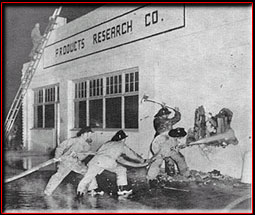
|
1969 - Chemical manufacturing plant fire. In 1968, Glendale went to a three platoon manning system. Each shift works a continuous 24 hour shift with manning of at least 50 personnel per shift. In 1973, Fire Chief Norm Stolley retired after 35 years of service. Allen R. Stone became the next Fire Chief. His sincere professionalism dedication in maintaining an efficient department allowed the department to acquire better equipment, more efficient communications and increased manpower. The adoption of the task force concept (a two-piece engine company) increased our capability to deliver a larger amount of water to a fire scene with fewer personnel. Chief Stone was instrumental in the creation of the tri-city Verdugo Communications Dispatch with the cities of Burbank and Pasadena. |
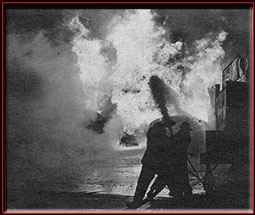
|
1984 Fire Chief John Montenero took the reigns from Chief Stone and continued to refine and develop the organization, helping it to become one of the finest fire departments in the country. He retired in 1991. In December of 2001, Fire Chief Richard Hinz retires and promotes Assistant Fire Chief Christopher Gray to succeed him. On December 31, 2001, Chris Gray became the Fire Chief and retired in August of 2007. Fire Chief Harold Scoggins was sworn in as the chief in May of 2008 and retired from the department in April 2015. Fire Chief Greg Fish became the current Fire Chief on September 1, 2015. He will continue to maintain the goal of protecting life and property while maintaining courtesy and service to the community of Glendale |
